Liza Perstneva Smart Remarketing Strategies #semrushchat Liza Perstneva 96 16 2 5 96 16 2 5
It’s almost impossible to convert all your website visitors, even if your site is amazing and your marketing campaign is excellent. It’s a fact. Nevertheless, remarketing, also known as retargeting, provides a great opportunity to get some of your visitors to return to your website and see your offer one more time.
Retargeting can be a powerful tool for online advertisers. If you’re not using it, you might be losing out on the opportunity to capture your audience that hasn’t been converted. If you’re already using it, you probably aren’t making the most of it.
In this SEMrush Chat recap, you’ll find several smart remarketing strategies for targeting users who were already interested in your product or service. We were excited to have Arnout Hellemans as our special guest. Arnout is a conversion expert and our regular chat participant. You can find more information about him on OnlineMarkethink.
Let’s delve into the topic!
Q1: What is your favorite retargeting platform and why?
First of all, we wanted to compare different retargeting platforms.
Our special guest believes that the choice of platform for retargeting depends on the project you’re working on. As such, Facebook is great for increasing brand awareness and generating leads, and a new LinkedIn platform that is going to launch in the foreseeable future will be huge for the B2B sector.
A1 For me any retargeting platform that get's me to micro target based on site interactions and has reach i'm open to. #semrushchat
— Arnout Hellemans (@hellemans) October 26, 2016
Arnout Hellemans admitted that he mostly uses a combination of Google Analytics and Google AdWords.
A1 But the most used by me is the combination of Google analytics and Adwords. #semrushchat
— Arnout Hellemans (@hellemans) October 26, 2016
Many other chat participants also mentioned AdWords. Joe Martinez said the service provides more retargeting options than most people can realize.
A1: AdWords personally. There are more targeting options with Google than most people realize. #semrushchat
— Joe Martinez (@MilwaukeePPC) October 26, 2016
There are many ways to retarget with AdWords, including video and email-list remarketing. Video remarketing means that you show your ads to people who have interacted with your videos or your YouTube channel. As for the latter, you can upload a list of email addresses provided by your customers, using Customer Match, so when these users are signed in to Gmail, Google Search, or YouTube, your ads are being displayed to them.
A1: Google has the wide reach of the entire GDN plus their main properties like Gmail, YouTube, etc. #semrushchat
— Miles Technologies (@milestech) October 26, 2016
Miles Technologies team mentioned SteelHouse and Coversant. SteelHouse is a data-driven marketing technology company that supplies a cloud-based advertising platform for acquisition and retention. This solution keeps your message in front of your audience through on-site, display, and social.
Coversant helps companies create personalized experience for their customers by providing an integrated personalization platform and personalized media programs.
Dawn Anderson mentioned Google AdWords too, but also said that she heard some good reviews about Nosto, an e-commerce platform. Nosto’s cross-platform remarketing tools provide customer re-engagement, strategic customer recapture and email retargeting. It analyzes the unique browsing and purchasing behavior of your online store visitors and provides product recommendations based on this information.
A1) I hear that Nosto is pretty amazing albeit I am just getting started with it #semrushchat
— Dawn Anderson (@dawnieando) October 26, 2016
In Julie F Bacchini’s opinion, Google Display Network has a better coverage for mobile users.
A1.1: Google Display Network (part of AdWords) has better coverage for mobile users. FB most mobile is viewed in their app. #semrushchat
— Julie F Bacchini (@NeptuneMoon) October 26, 2016
Let’s sum up!
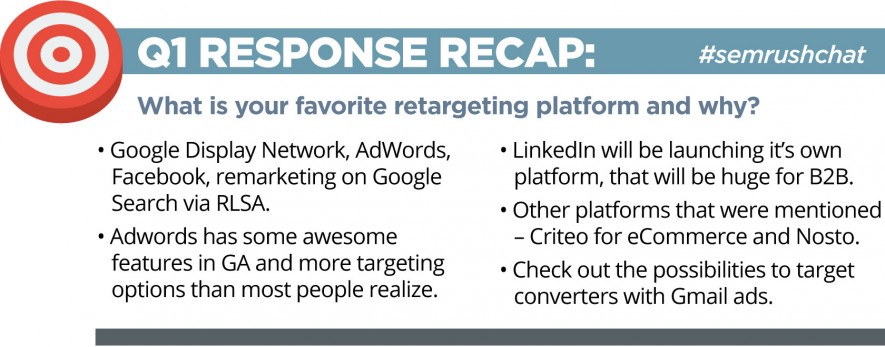
Most of our chat participants choose Google AdWords for their remarketing campaigns, but there’re also some useful options to test.
Q2: What are the biggest mistakes you see people make when setting up a retargeting campaign?
Some remarketing campaigns suffer from poor execution and, as a result, they don’t deliver desired results. Mistakes happen to the best of us. Anyway, forewarned is forearmed. We decided to discuss some common mistakes people make when setting up a retargeting campaign and how you can avoid them.
Here’s a list of mistakes that can damage your remarketing campaign.
-
No Frequency Capping
Forgetting to set a frequency cap is a huge mistake. Frequency is the average number of times a specific visitor sees your advertisement over a given period of time. By setting it too high you can make your users feel harrassed. At the same, if you set it too low they may not even notice your ad.
Neglecting the frequency cap means that every ad space you win will feature your advertisement, I doubt that you want your visitors to see the exact same ad again and again. “Two words – frequency capping. Please don't drown your (previous) visitors with ads every five minutes for three months!” tweeted ThinkSEM @ThinkSEM.
A2 No frequency cap, wrong placements, retargeting every site visitor (no exclusions)….please people.. #semrushchat
— Arnout Hellemans (@hellemans) October 26, 2016
-
Not Managing Placements
Managing placements allows you to choose the exact websites you want your advertisement to be displayed on. It provides you with more granular control over where your ads are being placed, earning the best return.
A2: Not managing placements. Yes, you want to get your name in front of people, but you need to do it when they'll be receptive #semrushchat
— Miles Technologies (@milestech) October 26, 2016
-
No Audience Exclusions and Segmentation
If you’ve already converted a user, you will obviously want to exclude them from your new remarketing campaign. Don’t be a stalker – exclude your site visitors who have already converted.
Also, if you don’t segment your audience into specific lists, your ads might not be very relevant to people who see them. Instead of just randomly targeting everyone, you can personalize your ads based on actions of your specific visitor or group of visitors on your site.
A2: Not segmenting, not creating specific content or offers. Not all visitors who hit your site are the same! #semrushchat
— Julie F Bacchini (@NeptuneMoon) October 26, 2016
-
No Individual Approach
David Kutcher made a very good point, saying that people who have already visited your site are not the same as your first-time visitors. Some marketers forget about it and make a mistake of treating their users in the same way they treat those people who visit their site for the first time.
An individual approach is very important. You’re unlikely to convert users with the same marketing tactics that didn’t convert them for the first time. You need to treat them differently.
A2) not understanding that retargeting is people already visited; treat them differently than just first-time visitors! #semrushchat
— David Kutcher (@confluentforms) October 26, 2016
-
Not Updating your Ads
Today Internet users are very impatient. They have the wealth of information at hand. If you can’t provide them with something interesting, new and fresh, you’ll lose. You have to be flexible, open to changes and test out different types of ads.
A2: Do you want to see the same TV ad for a year? No! Your remarketing ads need to change too. Keep testing new ads. #semrushchat
— Joe Martinez (@MilwaukeePPC) October 26, 2016
-
Not Having a Well-Thought-Out Strategy and a Solid Goal
Strategy is key. You need to carefully plan your remarketing campaigns and always keep your goal in mind. Otherwise, you are just acting blindly.
A2: Strategy. Or rather a lack of. Who are your customers and what is your goal? Stop wasting your money. #semrushchat
— Omi Sido (@OmiSido) October 26, 2016
Arnout Hellemans pointed out that running a fire-and-forget remarketing campaign is another big mistake. You need to always monitor and analyze your results.
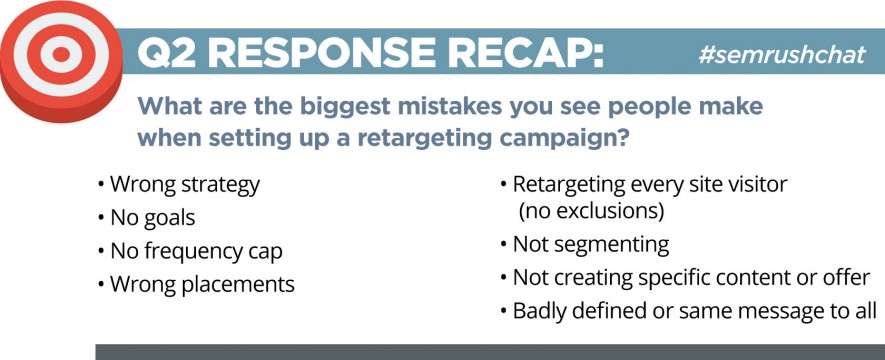
Keep these mistakes in mind and avoid them when setting your retargeting campaign.
Q3: Any awesome segments you’d recommend for the retargeting campaign of a SaaS company?
Segmenting your website visitors based on certain data points helps you direct more relevant and personalized messages to each of your users. The more relevant the message you deliver the better results your remarketing campaign will achieve.
We asked our chat participants to name retargeting segments for software-as-a-service (SaaS) companies.
To start with, Arnout Hellemans advised to track mouse hovers on your pricing and demo pages and then create User Buckets for Facebook and AdWords, based on this information.
A3 Start measuring hovers on the pricing and demo pages, create buckets for Facebook, Adwords etc based on that. #semrushchat
— Arnout Hellemans (@hellemans) October 26, 2016
Arnout also recommended to define the webpages that have visits with high conversion and then create audience segments.
Sarah Wilkes expressed her opinion that there’s no one-size-fits-all approach. You have to test different audience segments and understand your specific audience.
A3: There is no 'off the shelf' segment that can help all. You need to test them & understand your audience. #semrushchat
— Sarah Wilkes (@TrafficJamSarah) October 26, 2016
Omi Sido pointed out that since you’re already investing in content marketing you should be retargeting your blog visitors.
A3: Blog visitors – you're already investing in content marketing so you should be retargeting this audience.#semrushchat #useful #awesome
— Omi Sido (@OmiSido) October 26, 2016
By using AdWords Customer Match you can show your ads to specific users, based on data about these users that you share with Google. Customer Match is now available on Search, Gmail, and YouTube.
What you need to do is to upload a data file or a list of email addresses of your customers. Then create (or update) a campaign to target your Customer Match audience. This audience is a group of Google users who are your customers from your uploaded data file. When these users sign in to their Google account and start using Search, Gmail, and YouTube, they’ll see your ads. “Use Customer Match to try and get users to upgrade your service to the next level,” recommended Joe Martinez.
A3: I'd seriously think about Customer Match for your renewal list. #semrushchat
— Julie F Bacchini (@NeptuneMoon) October 26, 2016
Finally, James Gurd suggested to think about your purchasing cycle. By breaking up your buying cycle into several parts you can further refine your ads to induce users to complete a specific call to action.
A3) Think about purchase cycle e.g. user who abandons a path for 2nd time, higher intent than first time – remarket then #semrushchat
— James Gurd (@JamesGurd) October 26, 2016
You can check out a few other tips in the following recap.
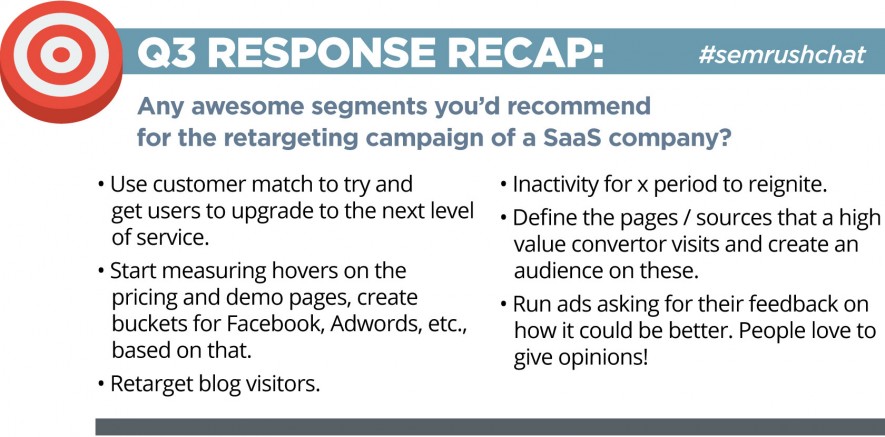
Our chat guests advised to use Customer Match, retarget blog visitors and test different audience segments to name but a few.
Q4: What audience segments and ad creatives would be a perfect match for each other?
To make sure your remarketing campaign delivers the right message to the right people, audience segmentation is essential. Here are several strategies that will help you ensure your audience segments and your ads create a perfect match.
First of all, our guest expert recommended to think about your buying cycle. You need to clearly understand where each individual is in the purchasing cycle to be able to move them along the path to purchase your product or service. Your ads and your offering should be pertinent to the needs and wants of each audience segment.
A4 In general; think buyer cycle and the fact that there are real people, segment and use logical sense when creating ads. #semrushchat
— Arnout Hellemans (@hellemans) October 26, 2016
“Don't generalize,” advised Arnout Hellemans. Your audience segments and ad creatives need to be relevant.
Joe Martinez suggested creating audience segments, based on their age and gender, in Google Analytics in order to target specific demographics.
A4: Create age/gender audiences in Google Analytics to target specific demographics. Create display ads showing those demos. #semrushchat
— Joe Martinez (@MilwaukeePPC) October 26, 2016
He also said you can create an audience in Google Analytics from AdWords keywords and then use that term in your remarketing ads as a psychological connection.
You can also try to use Smart Lists to automatically group your website visitors that are most likely to convert. In her article published on Search Engine Land, Rebekah Schelfhout pointed out that Smart Lists remove the need for re-evaluating your remarketing lists – it’s been proven that dynamic updates based on the latest criteria lead to conversion.
Reva Minkoff believes that audience segmentation based on geolocation and gender will be a good start.
A4. Geo and Gender are great places to start! #semrushchat
— Reva Minkoff (@revaminkoff) October 26, 2016
The Miles Technologies team suggested using dynamic ad creation. Dynamic ads mean personalized content. They are built in real time when ad requests are sent to a server. By using dynamic creative your ads can deliver content based on each customer and their specific behavior.
A4: Utilizing dynamic ad creation + retargeting of site visitors for any business that sells online or in retail locations #semrushchat
— Miles Technologies (@milestech) October 26, 2016
Also, our chat participants agreed that this is a very broad question, but your audience segments and ad creatives should definitely be relevant.
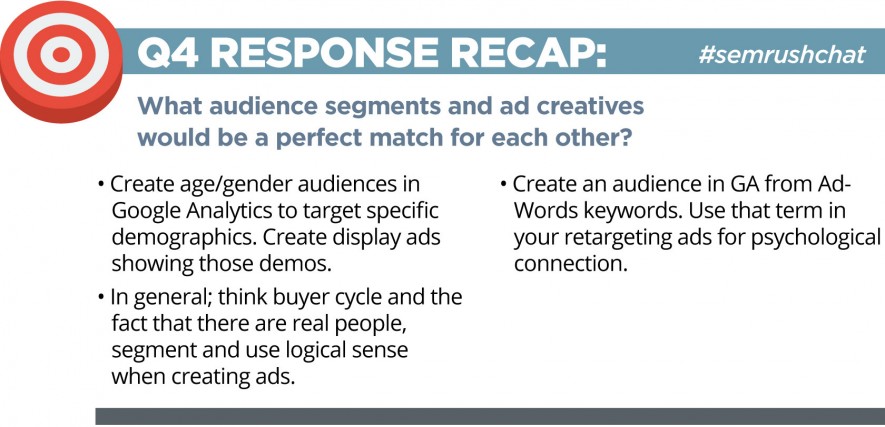
If you have any other tips on building audience segments, let us know in the comments!
Q5: What is the most creative retargeting campaign you've experienced or set up yourself and why?
At the end of our chat we asked our guests to share their most creative remarketing campaigns they’ve set up. Here’s a list of six creative retargeting campaigns.
-
How-To Videos
Our special guest shared his experience when he was promoting how-to videos for a BBQ company. The videos contained mouth-watering BBQ recipes. Today cooking videos are taking over social media with the purpose of compelling users to stop scrolling. And it’s actually working.
A5 Promote howto video's (in this case a BBQ company) with mouth watering bbq recipies (mind the weather though) #semrushchat
— Arnout Hellemans (@hellemans) October 26, 2016
-
A Campaign that Nurtures Customer-Brand Relationships
Create something that’s really useful. Your ad and your offering should have a real value. For example, Chenell Tull advised offering your customers a guide on how to use your product. Or, offer case studies, success stories, ebooks, product reviews, lists, podcasts and interviews, to name a few. “We love anything that adds more quality information to help build trust and authority with your target audience,” tweeted Web Themes Plus @webthemesplus.
A5: I love retargeting campaigns that nurture the relationship. Offering a guide on how to use a product I just bought, etc. #semrushchat
— Chenell Tull (@chenelltull) October 26, 2016
-
A Carousel on Facebook
The carousel format lets you show up to ten images and videos, as well as links, headlines or CTAs in a single ad unit. You can use your product imagery to target returning or high-intent users.
A5: Using carousel on @facebook to target multiple audiences in one go (email data & lookalike lists) – was pretty fun! #semrushchat
— Sarah Wilkes (@TrafficJamSarah) October 26, 2016
-
A Branding Campaign
What is the difference between a branding campaign and a call to action? A branding campaign is an advertising campaign not intended to evoke an immediate response. To be more specific, an immediate response is not its primary goal. The main purpose of branding is to develop favourable brand image and awareness in the minds of your users. Arnout Hellemans said that branding proved to be a successful retargeting campaign.
A5 Setup a branding campaign on a nice segment without CTA and get really targeted view at hardly any cost (on cpc platforms) #semrushchat
— Arnout Hellemans (@hellemans) October 26, 2016
-
Promoting VIP Tickets based on User’s Needs
Dawn Anderson also shared an interesting example of a retargeting campaign, when she was promoting tickets to an event about the product that users have just viewed. They expressed an interest in this product and that made them high-intent users.
A5) Promoting VIP tickets to an event about the product that they just viewed #semrushchat
— Dawn Anderson (@dawnieando) October 26, 2016
-
Time Delayed Retargeting
Johnathan Dane wrote about time delayed retargeting in his article “33 Retargeting Campaigns You’ve Never Heard Of Before.” If you run any type of cookie based retargeting, your audience is likely to have an expiration date. He pointed out that the best thing about time delayed targeting is that you don’t necessarily need accompanying landing pages to back up what your ad says and shows. If you already run an email nurturing campaign, you can take the subject lines from those emails and turn them into retargeting ads.
A5) Delayed remarketing campaigns for regular purchased products. Begin showing the ads when it’s soon time to repurchase #semrushchat
— Bryce Liggins (@BryceLiggins) October 26, 2016
Let’s sum up!
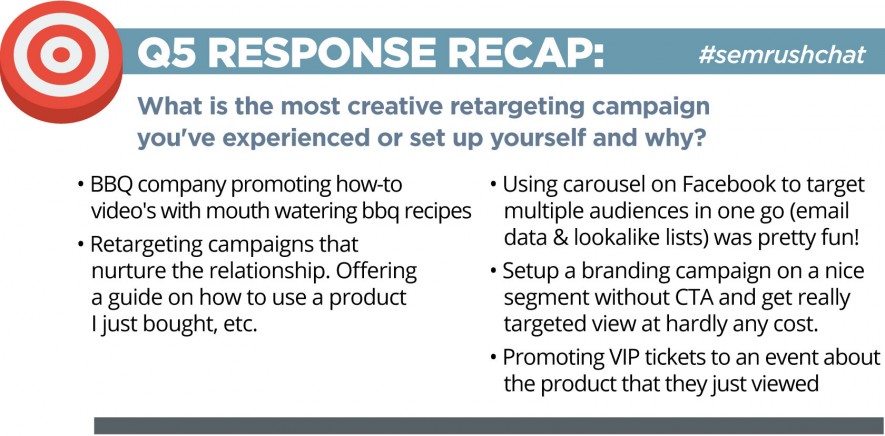
Maybe some of these campaigns will give you inspiration and fresh ideas for your next remarketing campaign.
That was our final question. We would like to thank Arnout Hellemans and our other chat participants who shared their knowledge and experience. We received many useful retargeting tips that will help you improve your campaigns.



